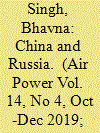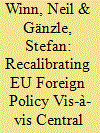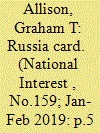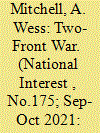|
|
|
Sort Order |
|
|
|
Items / Page
|
|
|
|
|
|
|
| Srl | Item |
| 1 |
ID:
170614


|
|
|
| 2 |
ID:
172559


|
|
|
|
|
| Summary/Abstract |
While China and Russia's general policies towards the Responsibility to Protect (R2P) are similar, the two reveal nuanced differences in addressing specific emergencies. Both express support for the first two pillars of R2P while resisting coercive intervention under its aegis, as they share anxieties of domestic political security and concerns about their international image. Nonetheless, addressing cases like the Syrian crisis, Russian statements are more assertive and even aggressive while Chinese ones are usually vague and reactive. This article highlights the two states’ different tones through computer-assisted text analyses. It argues that diplomatic styles reflect Russian and Chinese perceptions of their own place in the evolving international order. Experiences in past decades create divergent reference points and status prospects for them, which leads to their different strategies in signalling Great Power status. As Beijing is optimistic about its status-rising prospects, it exercises more self-restraint in order to avoid external containments and is reluctant to act as an independent ‘spoiler’. Meanwhile, Moscow interprets its Great Power status more from a frame of ‘loss’ and therefore is inclined to adopt a sterner approach to signal its status. Although their policies complement each other on many occasions, there is nothing akin to a Sino–Russian ‘bloc’.
|
|
|
|
|
|
|
|
|
|
|
|
|
|
|
|
| 3 |
ID:
181344


|
|
|
|
|
| Summary/Abstract |
US relations with China and Russia remain deeply problematic. Any hopes for change for the better under a Biden presidency were quickly dashed by the harsh Sino-US exchanges in Alaska in March and by the fallout from “SolarWinds,” Moscow’s brazen hacking attempt.1 No breakthroughs were expected or forthcoming at the US-Russia summit meeting in June, while celebrations of the Communist Party of China’s 100th anniversary in July reconfirmed Beijing’s strident foreign policy course. What’s more, Washington’s principal authoritarian rivals have been cooperating to mutual advantage. Summits between Xi Jinping and Vladimir Putin have been a hallmark of Sino-Russian diplomacy since 2013. It was telling that, right after the US-China encounter in Alaska, Foreign Ministers Wang and Lavrov met in Guilin, China to pointedly condemn Western “interference” in their internal affairs.
|
|
|
|
|
|
|
|
|
|
|
|
|
|
|
|
| 4 |
ID:
176321


|
|
|
|
|
| Summary/Abstract |
“The Navy spends a lot of time deployed around the globe preserving peace, not conducting high-end warfare, so it is critical we maintain flexibility in future air wings.” —Vice Admiral DeWolfe “Bullet” Miller, Commander, Naval Air Forces
|
|
|
|
|
|
|
|
|
|
|
|
|
|
|
|
| 5 |
ID:
191450


|
|
|
|
|
| Summary/Abstract |
With China and Russia acting more assertively vis-à-vis Central Asia, Kazakhstan, Kyrgyzstan, Tajikistan, Turkmenistan, and Uzbekistan have gradually moved to the core of contemporary Eurasian geopolitics – albeit to varying degrees. The European Union (EU) has purposefully sought to promote its norms and values in the region for quite some time in the past. However, considering the ongoing Western “polycrisis” exacerbated by the Covid-19 pandemic most recently, our paper investigates how the EU has been recalibrating its relationship towards Central Asia – within the timespan of its two EU Central Asia Strategies, dating from 2007 and 2019, respectively. We argue that the reformulation of EU policy towards Central Asia is pragmatically taking its lead from the growing constraints of EU foreign policy as well as Chinese and Russian intervention in the region; it is, in the end, geographical proximity that continues to shape geopolitics in Central Asia.
|
|
|
|
|
|
|
|
|
|
|
|
|
|
|
|
| 6 |
ID:
163949


|
|
|
| 7 |
ID:
140432


|
|
|
|
|
| Summary/Abstract |
This article examines Russia's position on the Senkaku/Diaoyu dispute. It focuses particularly on the claim that Russia and China are forming an anti-Japanese territorial front. Looking closely at official statements and actions, as well as Russian-language media and scholarship, it finds that Russia, while retaining a position of formal neutrality, clearly considers China's claims more favourably. While this could be seen to have alarming implications by arraying China and Russia on one side against Japan and the USA on the other, the article also finds that Russia's support is not without qualifications and that its place in the conflict is not yet entrenched.
|
|
|
|
|
|
|
|
|
|
|
|
|
|
|
|
| 8 |
ID:
181584


|
|
|
|
|
| Summary/Abstract |
The greatest risk facing the twenty-first-century United States, short of an outright nuclear attack, is a two-front war involving its strongest military rivals, China and Russia. Such a conflict would entail a scale of national effort and risk unseen in generations, effectively pitting America against the resources of nearly half of the Eurasian landmass.
|
|
|
|
|
|
|
|
|
|
|
|
|
|
|
|
|
|
|
|
|